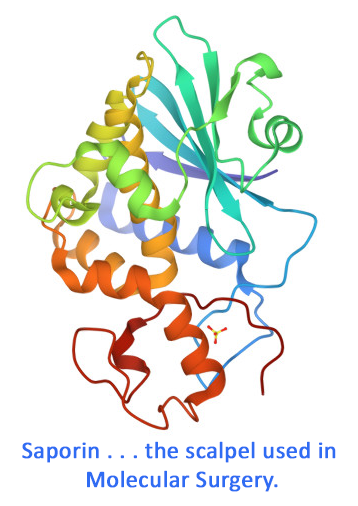CD45.2 is an alloantigen of CD45, also known as leukocyte common antigen or Ly-5 and is a transmembrane glycoprotein tyrosine phosphatase expressed on all nucleated hematopoietic cells. CD45.2 is expressed by all leukocytes and the mouse strains expressing Ly5.2 (e.g BALB/c, CBA/Ca, CBA/J, C3H/He, C57BL, C57BR, C57L, C58, DBA/1, DBA/2, NZB, SWR, 129). It is characterized by several isoforms and is distributed according to cell type and degree of cellular differentiation. CD45 has shown to play a role in the initiation of T-cell receptor signaling via activation of the tyrosine kinases Lck and Fyn. Deficiency of CD45 results in T and B-lymphocyte dysfunction characterized by severe combined immune deficiency. CD45 immunoreactivity is characteristic of autoimmune diseases and cancer such as non-Hodgkin’s lymphomas.
Anti-CD45.2-SAP is a bonded conjugate of biotinylated anti-CD45.2 and the secondary conjugate Streptavidin-ZAP (IT-27) containing the ribosome-inactivating protein, saporin. Anti-CD45.2-SAP specifically eliminates cells expressing CD45.2 in mice.
Anti-CD45.2-SAP is available individually (Cat. #IT-91) or as a kit (Cat. #KIT-91) which includes Anti-CD45.2-SAP and BIgG-SAP Mouse (Cat. #IT-74).
keywords: CD45, CD45.2, Anti-CD45, Anti-CD45.2, streptavidin, biotinylated, saporin, alloantigen, leukocyte common antigen, Ly-5, tyrosine, phosphotase, hematopoietic cells, T-cell receptor, tyrosine kinases, Lck, Fyn, immune deficiency, non-Hodgkin’s lymphoma, stem cell
Mobilization-based engraftment of haematopoietic stem cells: a new perspective for chemotherapy-free gene therapy and transplantation
Canarutto D, Omer Javed A, Pedrazzani G, Ferrari S, Naldini L (2023) Mobilization-based engraftment of haematopoietic stem cells: a new perspective for chemotherapy-free gene therapy and transplantation. Br Med Bull ldad017. doi: 10.1093/bmb/ldad017 PMID: 37460391
Objective: The authors review alternative chemotherapy-free approaches to niche voidance that could replace conventional regimens and alleviate the morbidity of the procedure.
Summary: In haematopoietic stem cell transplantation (HSCT), haematopoietic stem cells (HSCs) from a healthy donor replace the patient’s. Ex vivo HSC gene therapy (HSC GT) is a form of HSCT in which HSCs are genetically modified before infusion, to generate a progeny of gene-modified cells. In HSCT and HSC-GT, chemotherapy is administered before infusion to free space in the bone marrow niche, which is required for the engraftment of infused cells. One approach reviewed by the authors involves Anti-CD45-SAP. The conjugate was shown to clear the white blood cell compartment. Administration into mice prior to HSCT resulted in comparable haematopoietic reconstitution as total body irradiation, with less side effects (Palchaudhuri R. et al, 2016) and faster T-cell repopulation likely due to sparing radio damage to the thymic stroma (Schiroli G et al., 2017).
Related Products: Anti-CD45.2-SAP (Cat. #IT-91)
See Also:
Non-genotoxic conditioning for hematopoietic stem cell transplantation using a hematopoietic-cell-specific internalizing immunotoxin.
Palchaudhuri R, Saez B, Hoggatt J, Schajnovitz A, Sykes D, Tate T, Czechowicz A, Kfoury Y, Ruchika F, Rossi D, Verdine G, Mansour M, Scadden D (2016) Non-genotoxic conditioning for hematopoietic stem cell transplantation using a hematopoietic-cell-specific internalizing immunotoxin. Nat Biotechnol 34:738-745. doi: 10.1038/nbt.3584
Summary: To demonstrate correction of a clinically relevant disease, we employed CD45-SAP in a mouse model of sickle cell anemia and demonstrated our method achieved >90% donor cell chimerism, all mice in three groups (18/18), resulting in complete disease correction (red blood cell counts, hemoglobin levels, hematocrit levels and reticulocyte frequencies were returned to normal). If these pre-clinical results can be successfully translated to the clinic, it would greatly reduce conditioning-related toxicities and expand the use of hematopoietic stem cell transplantation.
Related Products: Streptavidin-ZAP (Cat. #IT-27), Anti-CD45.2-SAP (Cat. #IT-91)
Read the featured article in Targeting Trends.
Preclinical modeling highlights the therapeutic potential of hematopoietic stem cell gene editing for correction of SCID-X1.
Schiroli G, Ferrari S, Conway A, Jacob A, Capo V, Albano L, Plati T, Castiello M, Sanvito F, Gennery A, Bovolenta C, Palchaudhuri R, Scadden D, Holmes M, Villa A, Sitia G, Lombardo A, Genovese P, Naldini L (2017) Preclinical modeling highlights the therapeutic potential of hematopoietic stem cell gene editing for correction of SCID-X1. Sci Transl Med 9(411):eaan0820. doi: 10.1126/scitranslmed.aan0820
Objective: To study potential approaches to gene therapy in mouse models of severe combined immunodeficiency.
Summary: The threshold of IL2RG gene editing can be reached for safe and efficient correction of SCID-X1 established in a preclinical model in human long-term repopulating HSPCs.
Usage: Biotinylated Anti-CD45 was mixed equimolar to Streptavidin-ZAP and administered as a single dose which caused substantial depletion (~70%) of the HSPC compartments and milder depletion of the more mature cell populations.
Related Products: Streptavidin-ZAP (Cat. #IT-27), Anti-CD45.2-SAP (Cat. #IT-91)
Therapeutic Potential of Hematopoietic Stem Cell Gene Editing
browse all references for this product | back to top


Reviews
There are no reviews yet.